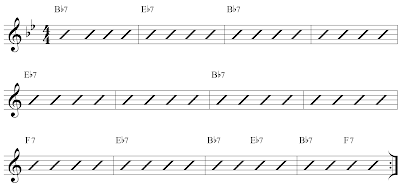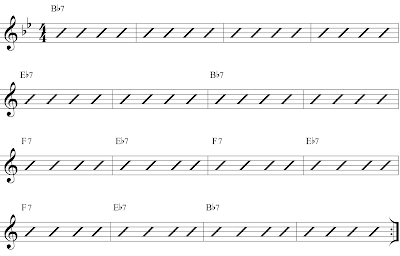How to Play the Most Popular Blues Progressions [8, 12, 16]
Learning to play Blues progressions is one of the most popular ways that guitar players will begin learning how to improvise... The common place sound of a blues jam, (combined with how quickly most guitarists will learn how to phrase lines with the Blues and Minor Pentatonic scales), will go a long way toward helping to speed up the time it takes to learn how to solo...
This is why guitar players need to know the most popular forms of Blues Progressions. These forms include the "8-bar, 12-bar, and 16-bar" Blues jams. And, that's why, this episode of the "Guitar Blog Insider," will cover "How to Play the Most Popular Blues Progressions."
WATCH THE VIDEO:
CHORD TYPES:
The examples in this lesson plan will all be from the key of "Bb Blues." Each chord will be of the Dominant 7th quality. Learn the chord fingering of the "I," "IV," "V" chord types shown below. These chords will include; "Bb7," "Eb7," and "F7."
8-Bar Blues: The first Blues progression we'll take a run through will be the popular 8-Bar format. Just like the name implies, this group of chord changes functions across 8-bars of music. The chord changes all operate using the common Dominant seventh chord types following the "I-IV-V" harmony (used as the bed-rock of the Blues Music Style). So, let's break down the chords and their order & sequence across the "8-bar" Blues progression...
8-Bar Blues Examples; "Worried Life Blues" (one of the most recorded blues songs of all time), Nina Simone's, "Trouble in Mind," and Buddy Guy's "Mary Had a Little Lamb." Plus, the song, "Heartbreak Hotel" by Elvis is also a early-rock variation on the 8-bar Blues format.
12-Bar Blues: Next, let's jump into the most popular group of Blues changes on planet Earth, the 12-Bar Blues. This is by far the most commonly applied group of Blues chord changes. This progression is used in thousands and thousands of songs and is an absolute "Must Learn" chord progression.
16-Bar Blues: Our final "important" Blues Progression is a progression that may not get a ton of prominent use like the famous "12-bar" Blues progression, but, it will be one of those Blues Progressions that are very important to learn about, it's the 16-bar Blues. Study the example below and the way that a typical 16-bar Blues progression moves across all of the measures with our; I-IV-V set of Dominant 7th chords.
16-Bar Blues Examples; The Beatles song - "The Ballad Of John And Yoko," also the Louis Armstrong piece -"Nobody Knows the Trouble I've Seen." And, from the 1920's Classic Blues era, there's the 16-bar piece (by Edward Thompson) called, "West Virginia Blues"
CONCLUSION:
These three examples of Blues progressions are important for all Guitarist's to become familiar with. Not only do they help guitar players better memorize the sounds of one of the most common styles of chord progression harmony (out there in music), but these Blues - chord progressions are an accepted group of arrangements that most other players you meet will also know.
Learning about these blues progressions will help you communicate better as a guitar player in many different musical situations. Study each progression. Do extra research of your own to learn some different chord combinations and above all else, learn songs that will use these progressions.
Next time you jam with a new group of musicians, there's a really good chance that they'll be more than happy to riff-out on a few, of these common 8-12- or 16 bar Blues progressions.
VISIT THE WEB-SITE:
Well, I'd like to end the discussion by saying, thanks for joining me... If you want to learn more about what I do as an online guitar teacher, then head over to my website at creativeguitarstudio.com and sign up your FREE lifetime membership... When you want more, you can always upgrade to either a Basic, or a Premium lesson package and start studying the guitar courses I've organized for the members of my website.
Also, I'd be interested to hear your thoughts on all of this in the comment section below... if you enjoyed this video, give it a thumbs up and subscribe for more. Thanks again and we'll catch up next week , for another episode of the, "Guitar Blog Insider."
This is why guitar players need to know the most popular forms of Blues Progressions. These forms include the "8-bar, 12-bar, and 16-bar" Blues jams. And, that's why, this episode of the "Guitar Blog Insider," will cover "How to Play the Most Popular Blues Progressions."
WATCH THE VIDEO:
CHORD TYPES:
The examples in this lesson plan will all be from the key of "Bb Blues." Each chord will be of the Dominant 7th quality. Learn the chord fingering of the "I," "IV," "V" chord types shown below. These chords will include; "Bb7," "Eb7," and "F7."
8-Bar Blues: The first Blues progression we'll take a run through will be the popular 8-Bar format. Just like the name implies, this group of chord changes functions across 8-bars of music. The chord changes all operate using the common Dominant seventh chord types following the "I-IV-V" harmony (used as the bed-rock of the Blues Music Style). So, let's break down the chords and their order & sequence across the "8-bar" Blues progression...
click on the above chart image to enlarge full-screen
8-Bar Blues Examples; "Worried Life Blues" (one of the most recorded blues songs of all time), Nina Simone's, "Trouble in Mind," and Buddy Guy's "Mary Had a Little Lamb." Plus, the song, "Heartbreak Hotel" by Elvis is also a early-rock variation on the 8-bar Blues format.
12-Bar Blues: Next, let's jump into the most popular group of Blues changes on planet Earth, the 12-Bar Blues. This is by far the most commonly applied group of Blues chord changes. This progression is used in thousands and thousands of songs and is an absolute "Must Learn" chord progression.
click on the above chart image to enlarge full-screen
16-Bar Blues: Our final "important" Blues Progression is a progression that may not get a ton of prominent use like the famous "12-bar" Blues progression, but, it will be one of those Blues Progressions that are very important to learn about, it's the 16-bar Blues. Study the example below and the way that a typical 16-bar Blues progression moves across all of the measures with our; I-IV-V set of Dominant 7th chords.
click on the above chart image to enlarge full-screen
16-Bar Blues Examples; The Beatles song - "The Ballad Of John And Yoko," also the Louis Armstrong piece -"Nobody Knows the Trouble I've Seen." And, from the 1920's Classic Blues era, there's the 16-bar piece (by Edward Thompson) called, "West Virginia Blues"
CONCLUSION:
These three examples of Blues progressions are important for all Guitarist's to become familiar with. Not only do they help guitar players better memorize the sounds of one of the most common styles of chord progression harmony (out there in music), but these Blues - chord progressions are an accepted group of arrangements that most other players you meet will also know.
Learning about these blues progressions will help you communicate better as a guitar player in many different musical situations. Study each progression. Do extra research of your own to learn some different chord combinations and above all else, learn songs that will use these progressions.
Next time you jam with a new group of musicians, there's a really good chance that they'll be more than happy to riff-out on a few, of these common 8-12- or 16 bar Blues progressions.
VISIT THE WEB-SITE:
Well, I'd like to end the discussion by saying, thanks for joining me... If you want to learn more about what I do as an online guitar teacher, then head over to my website at creativeguitarstudio.com and sign up your FREE lifetime membership... When you want more, you can always upgrade to either a Basic, or a Premium lesson package and start studying the guitar courses I've organized for the members of my website.
Also, I'd be interested to hear your thoughts on all of this in the comment section below... if you enjoyed this video, give it a thumbs up and subscribe for more. Thanks again and we'll catch up next week , for another episode of the, "Guitar Blog Insider."
___________________________________________________
GET GOOD NOW - JOIN THE MEMBERS AREA














